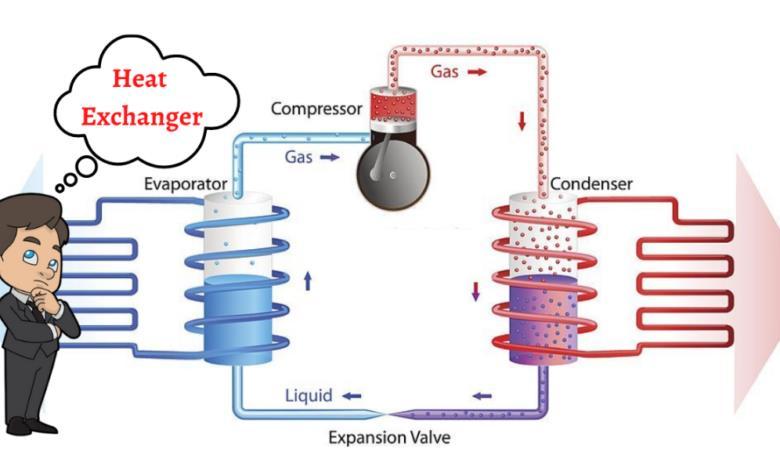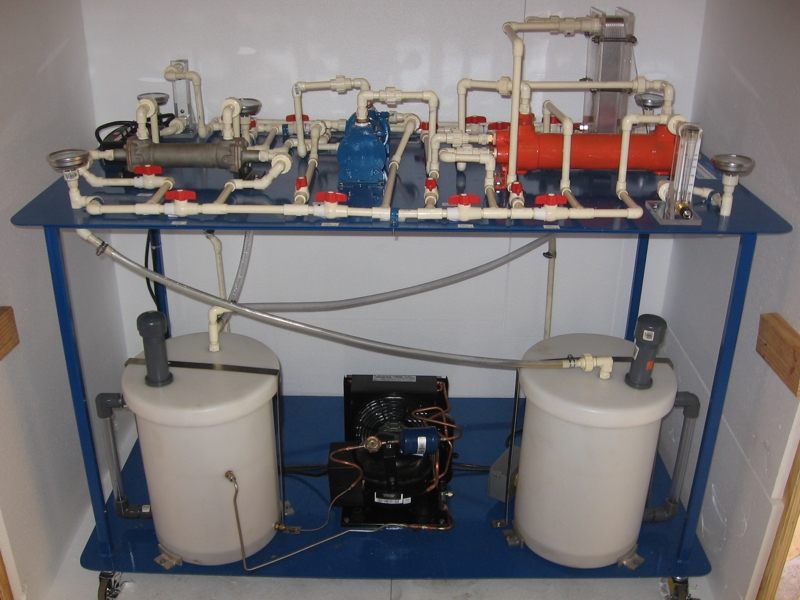How DVS Heat Transfer Systems Are Making Phase Change Materials More Efficient Than Ever
Advancements in Heat Transfer Solutions: What You Required to Know for Optimal Efficiency
Advancements in Heat transfer systems are transforming performance across numerous industries. Advanced materials like graphene and nanofluids guarantee considerable improvements in thermal conductivity. The integration of IoT and equipment understanding uses chances for real-time surveillance and boosted power effectiveness. The landscape of thermal management is rapidly evolving. Recognizing these growths is crucial for attaining ideal system efficiency and sustainability in the future. What specific innovations are shaping this improvement?
Emerging Products for Enhanced Heat Transfer

Advanced Heat Exchanger Styles
While typical Heat exchangers have offered their purpose in various applications, advanced styles are currently arising to satisfy the raising demands for performance and efficiency. These innovative layouts, such as plate, shell-and-tube, and finned-tube Heat exchangers, integrate enhanced surface areas and boosted flow patterns to enhance thermal transfer rates. Additionally, small styles enable lowered space demands without jeopardizing efficiency. Advanced products, such as compounds and corrosion-resistant alloys, in addition boost durability and efficiency under extreme conditions. Furthermore, simulation technologies and computational fluid dynamics are progressively employed to fine-tune these styles, making sure peak Heat transfer attributes. As markets look for to reduce power usage and optimize outcome, the adoption of innovative Heat exchanger styles is critical in attaining these purposes.
The Duty of Nanotechnology in Heat Transfer
Nanotechnology plays an important duty in enhancing thermal conductivity within Heat transfer systems. By controling products at the nanoscale, scientists have accomplished considerable enhancements in power performance. These developments not just maximize performance yet additionally add to more lasting energy solutions.
Boosted Thermal Conductivity
Considerable advancements in thermal conductivity have actually emerged with the application of nanotechnology, transforming Heat transfer systems throughout various sectors. By integrating nanoparticles right into Heat transfer fluids and products, researchers have actually attained impressive boosts in thermal conductivity. These nanoparticles, such as carbon nanotubes, graphene, and steel oxides, improve the Heat transfer homes as a result of their high surface and special thermal qualities. The resulting compounds display enhanced efficiency in applications varying from electronic devices cooling down systems to renewable resource technologies. Moreover, the capacity to tailor the dimension, shape, and composition of nanoparticles enables for enhanced thermal monitoring services. Consequently, nanotechnology continues to play a critical role in the development of much more reliable and reliable Heat transfer systems, leading the method for boosted commercial applications.
Power Performance Improvements

Combination of IoT in Heat Transfer Equipments
The combination of IoT in Heat transfer systems presents the implementation of wise sensors that improve operational performance. These sensing units allow real-time information surveillance, permitting immediate adjustments and optimizations. This technical advancement has the potential to significantly enhance performance and energy administration in DVS Heat Transfer Systems Heat transfer applications.
Smart Sensors Application
As Heat transfer systems evolve, the combination of smart sensors through the Net of Points (IoT) has become a transformative approach. These sensors enable real-time monitoring of pressure, temperature level, and flow prices, boosting system effectiveness and integrity. By collecting and transferring data, they assist in aggressive maintenance, decreasing the threat of system failures. Furthermore, smart sensors add to power savings by refining operational criteria based on ecological problems. Their capacity to evaluate abnormalities and patterns enables notified decision-making, guaranteeing peak performance of Heat transfer systems. As sectors increasingly adopt this innovation, the implementation of smart sensing units stands to transform how Heat transfer systems are taken care of, paving the means for higher sustainability and boosted efficiency outcomes.
Real-Time Information Surveillance
Exactly how can real-time data monitoring boost the performance of Heat transfer systems? By incorporating Internet of Points (IoT) technology, Heat transfer systems can take advantage of constant data collection from smart sensors. This real-time surveillance permits prompt evaluation of pressure, circulation, and temperature level prices, making it possible for drivers to recognize inefficiencies without delay. Changes can be made to enhance performance, reduce energy usage, and extend equipment lifespan. Additionally, anticipating maintenance can be carried out, minimizing unanticipated downtime and pricey repair services. The capacity to visualize performance metrics via control panels enhances decision-making, cultivating a proactive method to system management. Eventually, real-time data checking not just improves operational effectiveness yet also adds to sustainability goals within commercial processes.
Power Efficiency and Sustainability Trends
Power performance and sustainability trends are improving the landscape of Heat transfer systems, driving technology and conformity throughout various markets. Organizations are increasingly prioritizing energy-efficient layouts to minimize functional expenses and reduce ecological effects. The integration of renewable resource resources is coming to be much more prevalent, making it possible for Heat transfer systems to run sustainably while satisfying regulatory demands. In addition, advancements in materials and technologies advertise reduced energy intake and boost total efficiency. Lifecycle assessments are additionally obtaining grip, allowing firms to examine the environmental impact of Heat transfer systems from production to disposal. This concentrate on sustainability not only supports business responsibility however additionally positions organizations competitively in a market where customers increasingly prefer environmentally friendly options. Energy performance and sustainability remain critical factors to consider for future growths in Heat transfer innovation.
Technologies in Thermal Management Solutions
While the demand for efficient Heat transfer continues to increase, technologies in thermal monitoring remedies are emerging to deal with both performance and sustainability difficulties. Advanced materials, such as stage adjustment products and nanofluids, are being developed to improve Heat transfer efficiency - DVS Heat Transfer Systems. These products boost thermal conductivity and permit for better temperature regulation in various applications. In addition, modern technologies like energetic thermal control systems are gaining grip, making it possible for real-time adjustments to manage Heat flow efficiently. These systems contribute to energy savings and minimize the ecological influence of thermal procedures. The combination of IoT in thermal administration promotes monitoring and predictive maintenance, making sure maximized performance and durability of Heat transfer systems. On the whole, these developments stand for significant strides towards more lasting thermal administration techniques
Future Instructions in Heat Transfer Modern Technology
Arising developments in thermal administration services signal an encouraging future for Heat transfer modern technology. Researchers are significantly concentrating on creating materials with premium thermal conductivity and improved energy effectiveness. Advancements such as nanofluids, which have put on hold nanoparticles, provide considerable renovations in Heat transfer efficiency. In addition, the combination of clever materials that adapt to differing temperature conditions is acquiring traction, enabling even more efficient and responsive systems. The rise of additive production strategies is additionally allowing the design of intricate Heat exchanger geometries that enhance liquid flow. Additionally, the execution of maker discovering formulas is expected to change the optimization of Heat transfer systems, facilitating predictive maintenance and efficiency enhancement. Jointly, these developments are positioned to change the landscape of Heat transfer innovations in different markets.

Often Asked Questions

Exactly how Do I Select the Right Heat Transfer System for My Application?
Picking the appropriate Heat transfer system entails evaluating application requirements, consisting of temperature level ranges, fluid properties, and efficiency demands. Evaluating system kinds, upkeep considerations, and cost-effectiveness additionally plays a necessary role in making a notified choice.
What Are the Maintenance Demands for Advanced Heat Exchangers?
Upkeep demands for advanced Heat exchangers generally include regular examinations, monitoring for leakages, cleaning of surface areas, and guaranteeing perfect circulation prices. Complying with supplier guidelines guarantees efficient operation and lengthens the tools's lifespan.
Exactly How Do Ecological Variables Impact Heat Transfer Efficiency?
Ecological variables considerably affect Heat transfer efficiency. Variants in temperature, moisture, and air flow impact thermal conductivity and convective Heat transfer, eventually affecting system performance and demanding consideration during the style and operation of Heat transfer systems.
What Safety Standards Apply to Heat Transfer Systems?
Security standards for Heat transfer systems typically include standards from organizations such as ASME and ASTM. DVS Heat Transfer Systems. These criteria address products, layout, and operational practices to ensure reliability, efficiency, and defense against threats in different applications
Exactly How Can I Troubleshoot Common Heat Transfer System Issues?
Troubleshooting common Heat transfer system concerns includes checking for leaks, ensuring correct liquid circulation, checking insulation honesty, and confirming temperature level differentials. Identifying these factors can help keep system performance and stop further issues.
Nanotechnology plays a crucial role in improving thermal conductivity within Heat transfer systems. Considerable improvements in thermal conductivity have actually arised through the application of nanotechnology, revolutionizing Heat transfer systems across different sectors. Innovations in thermal conductivity via nanotechnology have actually led the means for exceptional renovations in power efficiency within Heat transfer systems. Power performance and sustainability patterns are improving the landscape of Heat transfer systems, driving development and conformity throughout various markets. The assimilation of IoT in thermal management promotes tracking and predictive upkeep, guaranteeing maximized performance and long life of Heat transfer systems.